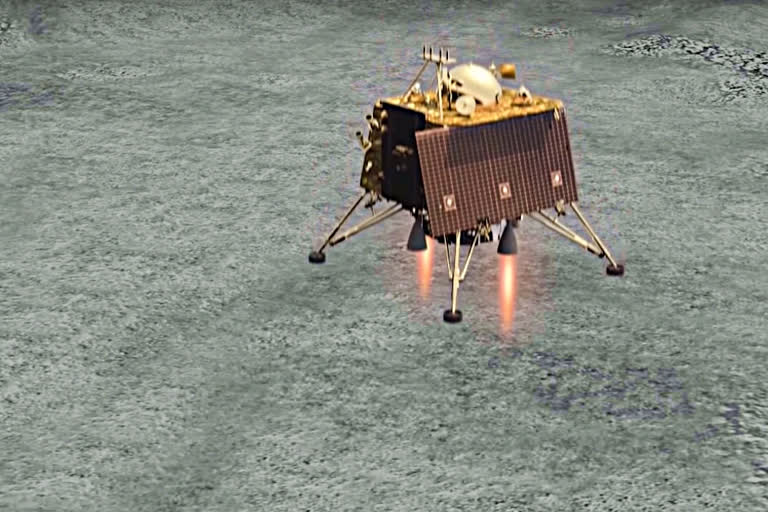Bengaluru: Hours before Chandrayaan-2's 'Vikram' module's proposed soft landing on the Lunar surface, ISRO Chairman K Sivan said on Friday things are progressing as per plan for the much-awaited event.
"We are eagerly waiting for the event. Everything is going according to the plan," Sivan told a news agency on Friday.
The touch-down of 'Vikram' lander is scheduled between 1.30 am and 2.30 am on Saturday, followed by the rollout of rover 'Pragyan' between 5.30 a.m and 6.30 a.m.
The soft landing will be telecast live from 1.10 a.m on Doordarshan, webcast on ISRO website and streamed on YouTube, Facebook and Twitter.
"Certainly there is a lot of anxiety in the minds of the entire (Chandrayaan-2) team because it's a very complex operation and we are doing it for the first time," a senior an official associated with the mission said on condition of anonymity.
"Everything... sensors, computers, command systems... has to work perfectly. But we are confident in the sense we have conducted a large number of simulations on the ground; it gives us the confidence it would go alright," the official said.
He described the soft-landing as "almost like placing a baby on the cradle", and said, "there is a certain amount of anxiety but there is no fear." Prime Minister Narendra Modi, dozens of students from across the country selected by ISRO through an online quiz, a large media contingent and others are slated to watch the event as it happens, from the ISRO Telemetry Tracking and Command Network (ISTRAC) here.
As India attempts a soft landing on the lunar surface, all eyes will be on the lander 'Vikram' and rover 'Pragyan'.
The 1,471-kg 'Vikram', named after Dr Vikram A Sarabhai, the father of the Indian space programme, is designed to execute a soft landing on the lunar surface, and to function for one lunar day, which is equivalent to about 14 earth days.
Chandrayaan-2's 27-kg robotic vehicle 'Pragyan', which translates to 'wisdom' in Sanskrit, can travel up to 500 metres from the landing spot on the Moon and leverages solar energy for its functioning.
"The lander carries three scientific payloads to conduct surface and sub-surface science experiments, while the rover carries two payloads to enhance our understanding of the lunar surface," according to ISRO.
'Vikram' will perform a series of complex braking manoeuvres to soft-land in the South polar region of the Moon between two craters, Manzinus C and Simpelius N, on September 7.
A few hours later, the rover will roll down from 'Vikram' and will explore the surrounding lunar terrain.
Chandrayaan-2, a follow-on mission to the Chandrayaan-1 venture launched more than a decade ago, comprises an orbiter, lander (Vikram) and rover (Pragyan).
The mission life of the orbiter will be one year while that of the lander and rover will be one lunar day which is equal to 14 earth days.
A successful touch-down will make India the fourth country after Russia, the US and China to achieve a soft landing on the moon, and the first to launch a mission to the unexplored south polar region.
Sivan recently said the proposed soft landing was going to be a "terrifying" moment as the ISRO has not done it before.
The Chandrayaan-2 is a Rs 978 crore unmanned moon mission (satellite cost Rs 603 crore, GSLV MK III cost Rs 375 crore). India's Geosynchronous Satellite Launch Vehicle, GSLV MkIII-M1 successfully launched the 3,840-kg Chandrayaan-2 spacecraft into the Earth's orbit on July 22.
The spacecraft began its journey towards the moon leaving the earth's orbit in the dark hours on August 14, after a crucial manoeuvre called Trans Lunar Insertion that was carried out by ISRO to place the spacecraft on "Lunar Transfer Trajectory."
The spacecraft successfully entered the lunar orbit on August 20 by performing Lunar Orbit Insertion (LOI) manoeuvre.
On September 2, 'Vikram' successfully separated from the orbiter, following which two de-orbiting manoeuvres were performed to bring the lander closer to the Moon. The health of the spacecraft is being continuously monitored from the Mission Operations Complex at ISTRAC here with support from Indian Deep Space Network (IDSN) antennas at Bylalu, near Bengaluru.
The orbiter carries eight scientific payloads for mapping the lunar surface and study the exosphere (outer atmosphere) of the Moon, according to ISRO officials.
Also read: Gandhi and Tagore: Counter-Enlightenment ideologues who discarded European modernity



